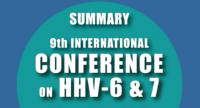A summary of the highlights from the 9th International conference on HHV-6 & 7, held in Boston in November 2015, has been published. This summary may be downloaded free of charge from the Foundation web site at this link, from May 25 through August 1st. Many thanks to Anthony Komaroff, MD and the Conference Co-Chairs Louis Flamand, PhD and Philip Pellett, PhD for preparing this summary and to the editors of the journal for making the summary available free of charge for this period. The conference highlights include the following topics:
Biology of Human HHV-6A and HHV-6B
-Isoforms of CD46 influence cell entry
-The role of CD134 as a receptor for HHV-6B
-The role of HHV-6 in initiating mitochondrial fission
-HHV-6 infection and p53
-U21, a protein that aids HHV-7 in evading immune recognition
-Molecular targets of CD4+ cell response to HHV-6B
Chromosomally Integrated HHV-6 Biology and Epidemiology
-Mechanisms for integration
-Cell line to study chromosomal integration
-Production of infectious virions from iciHHV-6A/B
-Association of iciHHV-6 with angina pectoris
-Possible increased risk of iciHHV-6 in HSCT and organ transplants
-Possible role for iciHHV6 in familial glioma
Diagnostics
-ddPCR as a tool to identify iciHHV-6
-Quantitative RT-PCR to analyze HHV-6B transcriptome in HSCT patients
Animal Models of roseolovirus-related Disease
-New human roseolovirus homologues identified in primates.
-Mouse Thymic Virus revealed as a beta-herpesvirus
-Transgenic mouse model of HHV-6A infection
HHV-6 in Disease
-HHV-6 DNA more abundant in brains of patients with encephalopathy
-HHV-6 as a possible cause of idiopathic pneumonia syndrome
-HHV-6 activation of a MS-associated retroviral element
-HHV-6 acceleration of EAE in a marmoset model
-HHV-6 impairment of repair remyelination
-HHV-6 infection of thyroid cells may trigger AITD
-HMGB-1 may be responsible for high rate of HHV-6 infection in DIHS
-HHV-6A may be a cause of infertility
Treatment
-Adoptive immunotherapy encouraging for HHV-6 infection
-HIV integrase inhibitors may treat HHV-6 infection
-MBX-400 active against HHV-6 infection
-Nuceloside analog ZSM-I-62 effective against HHV-6
-Broad spectrum K-21 effective against HHV-6A, HHV-7
Challenges
Establishing a causal role of HHV-6 requires several of the following:
- Finding HHV-6 DNA or antigens in higher abundance of diseased tissue
- Finding other infectious agents in much lower abundance
- An immune response to HHV-6 in tissue or blood
- DNA levels that are higher during disease flares
- A virological response to antiviral therapy
In many conditions, it is still unclear if the virus is:
- The cause of the disease
- A co-factor that contributes to pathology
- An epiphenomenon, reactivated by the disease
- An innocent bystander that does not contribute to pathology
Coauthors of the summary were:
Anthony Komaroff, MD (Harvard University School of Medicine
Tuan Phan (HHV-6 Foundation)
Louis Flamand, PhD (Laval University)
Philip Pellett, PhD (Wayne State University)
Read the full text here: Komaroff 2016.

